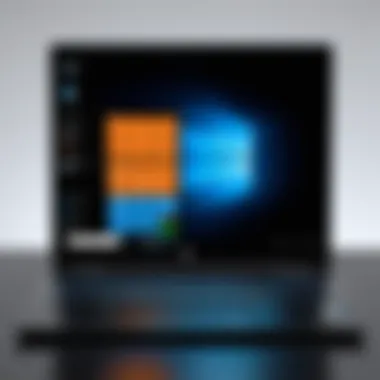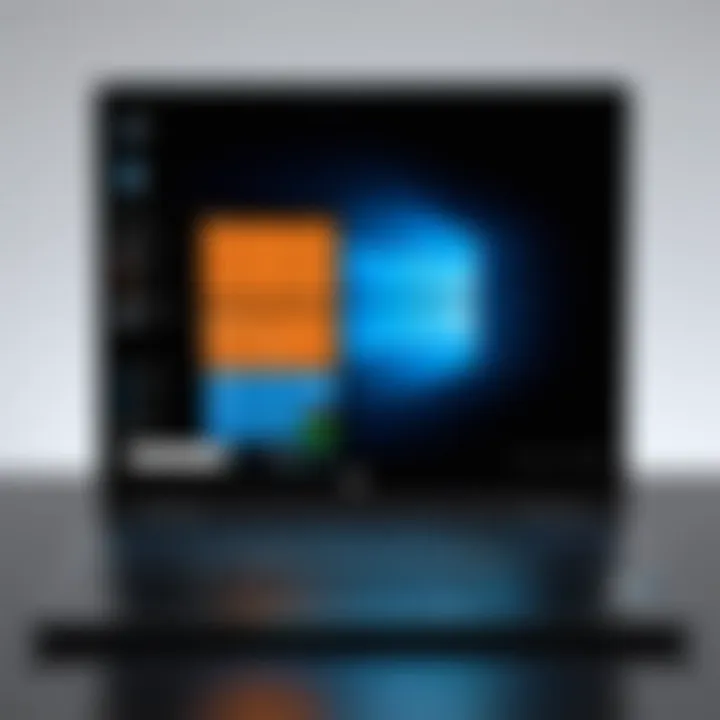Guide to Effectively Uninstalling Software on Windows 10


Intro
Uninstalling software on Windows 10 is more than just a few clicks in the settings; it can often be a labyrinthine process for users, particularly for the less tech-savvy. The sheer variety of applications, ranging from lightweight tools to hefty suites, adds layers of complexity. This guide delves into the nuances of uninstalling software, aimed primarily at those who navigate the world of IT and tech enthusiast communities. Along the way, we will tackle common hurdles many individuals face, provide effective strategies to overcome these, and discuss both standard and alternative methods for removal. In the end, a thorough understanding of these processes not only streamlines your system but optimizes its performance.
Hardware Overview
When it comes to uninstalling applications, understanding the hardware that supports Windows 10 can be quite beneficial. Knowing how hardware works in conjunction with software can lead to informed decisions about what should and shouldn’t be uninstalled.
Specifications
The specifications of a computer dictate what software it can effectively run. For instance, a system with minimal RAM might struggle under the weight of multiple high-performance applications. Here are factors to keep in mind:
- Processor (CPU): The number of cores and clock speed can influence the performance of software. More demanding applications may require a multi-core processor for smooth operation.
- Memory (RAM): Software takes up space. The amount of RAM available can affect how many programs can run simultaneously without slowing down the system.
- Storage type: SSDs provide faster read/write times than HDDs. This speed can significantly impact how quickly software uninstalls.
Performance Metrics
Understanding how performance metrics can be affected post-uninstallation is key. After removing unused applications, it’s common to notice an uptick in system speed. This can often be attributed to freeing up:
- CPU Resources: Unused software can hog processing power, and removing them may enhance responsiveness.
- Disk Space: Regularly uninstalling applications that no longer serve a purpose can free valuable storage space over time, leading to better system performance.
Software Analysis
Examining the software ecosystem within Windows 10 aids in identifying not just what to uninstall but also why certain applications may need to be retained or replaced.
Features and Functionality
Software features can vary widely. Some applications offer robust tools for specific tasks but may also include components that bloat the system or execute background processes without user knowledge. Uninstalling software can:
- Enhance Focus: Fewer programs can reduce distractions, allowing users to concentrate on critical tasks.
- Improve Compatibility: Legacy software can cause conflicts with newer applications. Removing outdated programs may resolve these issues.
User Interface and Experience
A clean uninstall process usually requires navigating a user interface that can be as straightforward or complicated as the software itself. Key points regarding user interface include:
- Intuitive Layout: An easy-to-navigate interface during uninstallation can save time and frustration.
- Confirmation Prompts: These are crucial. They prevent accidental removals and allow users to reassess their choices.
"You can’t put new wine into old bottles." – This saying aptly fits software management; without proper cleanup, new installations could falter under the weight of their predecessors. If you want to keep your Windows 10 performing at its best, a routine software check is essential.
Navigating software uninstallation doesn't have to feel like solving a Rubik's Cube. By understanding the hardware at play and analyzing the software landscape, you'll equip yourself with the knowledge needed to enhance your digital environment.
Understanding Software Installation in Windows
Software installation on Windows 10 is a foundational element of utilizing a modern computer. With a seamless and intuitive operating system, Microsoft has aimed to make the installation and management of software accessible to everyone—from casual users to seasoned IT professionals. Understanding this process is crucial for maintaining a well-functioning system. When you grasp how software installations work, it sets the stage for better management, improves performance, and allows for more strategic decision-making regarding the applications you choose to keep.
The Importance of Software Management
Managing software effectively isn't just a tedious task; it's a necessity for optimal system health. Software management encompasses monitoring, controlling, and organizing the software that resides on your machine. When you know what software is installed, how it operates, and its relevance to your needs, you can make informed decisions.
Neglecting this aspect may lead to various issues, like performance slowdowns, security vulnerabilities, or even complete system failure. Think of it like cleaning out your garage; without regular upkeep, clutter builds up, making it increasingly difficult to find what you need. Proper software management enables you to streamline your digital workspace and keeps everything running smoothly.
Types of Software Available
Understanding the types of software available helps clarify what you can install and manage. In Windows 10, we generally categorize software into three main types:
- Native Applications: These are software programs developed specifically for Windows. They often come pre-installed, or can be installed from the Microsoft Store, ensuring compatibility and smoother integration.
- Third-party Software: This category includes programs developed by external companies and individuals. The rich ecosystem of third-party software provides virtually any functionality you might need.
- System Utilities: These are specialized applications designed to manage, maintain, and troubleshoot your Windows environment. They are usually lightweight and essential for performance.
- Key Characteristic: Usually optimized for system performance and stability, Native Applications utilize system resources efficiently.
- Why It’s Beneficial: Their close alignment with the operating system minimizes conflicts, making them a popular choice among users.
- Unique Feature: Native Apps can leverage system features like Cortana and Windows Hello, which can enhance user experience.
- Key Characteristic: These applications often introduce innovative features not available in Native Applications.
- Why It’s Beneficial: Third-party software fills the gaps, offering specialized functionalities tailored to specific user requirements.
- Unique Feature: The downside is that compatibility issues with Windows can arise, leading to software bugs or crashes.
- Key Characteristic: These tools are focused on system efficiency and performance monitoring, like temporary file removers and disk defragmenters.
- Why It’s Beneficial: System Utilities can proactively maintain your environment, ensuring everything runs as it should.
- Unique Feature: While they are critical for maintenance, improper use can lead to unwanted changes or system instability.
The Need for Uninstalling Software
In a world where digital clutter can slow down performance and create confusion, understanding the need for uninstalling software becomes crucial. Whether you're a seasoned IT professional or just dipping your toes into software management, knowing when and how to remove unnecessary programs can greatly enhance your system’s efficiency and security. More than just clearing up space on your drive, it is about maintaining an environment that is smooth, functional, and tailored to your needs.
Common Reasons for Uninstallation
Performance Issues
One of the primary reasons users opt for uninstallation stems from performance issues. Whenever you install more software than necessary, your system may lag. Over time, a plethora of applications can create bottlenecks, making your machine feel slower than molasses in January. This not only frustrates users but may also diminish their productivity.
The key characteristic here is the impact on speed. When software runs in the background, it can suck up memory and processing power, leading to noticeable delays when opening programs or even booting up your computer. This article emphasizes addressing performance issues upfront, because quick machines tend to keep users happier and more efficient.
Removing applications that are rarely used and drain resources can rejuvenate your system, resulting in faster load times and a more responsive user experience.


Mismatched Functionality
Next, we have mismatched functionality, which occurs when software doesn't quite gel with what you need. Imagine buying a fancy blender that could theoretically make soup but ends up sputtering halfway through. Similarly, software might promise features it doesn’t deliver or may clash with existing systems.
This aspect emphasizes the need for evaluating software relevance. Ideally, users should always be armed with applications that align closely with their specific tasks. Removing those that don’t serve a real purpose leads to a streamlined setup. It also prevents the confusion caused by multiple software performing similar roles, thereby keeping workflows smooth and efficient.
Software Obsolescence
Lastly, software obsolescence plays a significant role here. As technology evolves, older software may no longer receive updates, becoming outdated and more vulnerable to exploits. It’s like keeping an old lock on your front door while thieves develop new tools; you wouldn't do that, would you?
This article highlights the reality that older programs not only lack functionality for modern tasks but also ramp up security risks. Users should make a routine of evaluating their software to dump what has become obsolete, providing a more secure environment, eliminating vulnerabilities while making way for up-to-date tools that better serve current needs.
Risks of Keeping Unnecessary Software
Security Vulnerabilities
Security vulnerabilities are perhaps the most critical concern when it comes to leaving unnecessary software installed. Each piece of software represents a potential entry point for cybercriminals. If a program is outdated or no longer maintained, it’s akin to leaving a window open in a storm. This article stresses that avoiding unnecessary installations reduces the number of potential vulnerabilities in your system, thus enhancing overall security.
Resource Drain
Resource drain is another serious issue. Some unsuspecting applications can run in the background, eating away at your CPU and memory, leading to inefficient performance. This resource consumption comes at a cost, as it conflicts with the performance of other necessary tasks. In this article, we stress the importance of careful resource management to maintain an efficient work environment.
System Clutter
Finally, system clutter can lead to chaos. Without regular uninstallation habits, it’s easy to let various applications pile up, making it difficult to find what you actually use or need. This article argues that reducing system clutter elevates not only performance but also the overall user experience, fostering a cleaner and more organized layout.
Thus, understanding the need to uninstall software is fundamental. By recognizing the performance impacts, evaluating functionality, and being wary of security implications, users can maintain their systems and achieve a more efficient computing experience. The importance of this topic cannot be overstated, given that it lays the groundwork for subsequent discussions on how to effectively manage software installations.
Uninstalling Through Control Panel
When it comes to managing software on Windows 10, knowing how to uninstall applications through the Control Panel is essential. This method is not just about hitting a few buttons. It's a comprehensive approach that ensures you've removed software completely, making way for better performance and more storage. For many users, the Control Panel remains a familiar environment, despite the growing adoption of the Settings app. Understanding this process is vital for IT professionals and tech enthusiasts who want to maintain a clean and efficient system.
Accessing the Control Panel
To begin the uninstallation process, you’ll first need to access the Control Panel. This can be more challenging than it seems. Windows tends to hide it behind a few clicks. Here’s how to find it:
- Press the Windows key or click on the Start menu.
- Type Control Panel into the search box.
- Click on the icon that appears in the search results.
If you’re running Windows 10, you might not see the Control Panel right away because the Settings app is promoted. Still, this classic interface holds significant importance for tasks like uninstalling software. Once opened, you’ll feel right at home, ready to dive deeper into software management.
Navigating to Programs and Features
Once you have the Control Panel open, the next step is to navigate to “Programs and Features.” It’s essential to go here as it lists all the software installed on your device in one place. Finding this section is straightforward:
- Look for the Programs option, which might be listed as Programs and Features.
- Click on that, and you’ll be presented with a list of all applications installed on your system.
This list gives you a bird's-eye view of your software landscape, enabling you to identify what you want to uninstall. Keeping track of what’s installed can aid in the larger scheme of software management.
Step-by-Step Uninstallation Process
Now that you’ve landed in the right spot, it’s time to go through the uninstallation process step-by-step. It’s pretty straightforward, but attention to detail is key:
- Select the software you wish to uninstall from the list.
- Right-click on it, or select it and click on the Uninstall option that appears at the top of the window.
- Follow the prompts that appear. Some software might require additional confirmations or might let you choose to preserve certain settings or data.
- Once you’ve confirmed, sit back as Windows takes care of the rest.
Keep in mind, the uninstallation process may take some time depending on the size of the software and its components.
After you’ve uninstalled, it’s a good practice to check for any leftover files or registry entries, just to keep the system tidy. While the Control Panel does a solid job of removing the bulk of the application, some residual data might still linger.
Understanding this process not only empowers users but also enhances the overall experience when it comes to maintaining a healthy software environment. By mastering the Control Panel method, you ensure a tidier system with space to breathe.
Using the Settings App for Uninstallation
The Settings app in Windows 10 has transformed how users manage their software. While the Control Panel offered a user-friendly approach, the Settings app enhances the experience, providing a cleaner interface and a more straightforward process for uninstalling applications. Understanding this process is essential for ensuring optimal software performance and maintaining a clutter-free system. Using the Settings app can save time and reduce the frustration often associated with software management.
Finding the Settings App
Locating the Settings app is as simple as pie. You can find it in various ways:
- Start Menu: Click the Start button (the Windows logo), which will show you a list of all your applications. Scroll down and look for the gear icon - that's your gateway to the Settings.
- Search Function: Alternatively, if you'd prefer a quicker route, just type "Settings" into the search bar next to the Start Menu. The app should pop up like a genie out of a lamp.
Getting your bearings in the Settings app will make it easier to navigate through its features and functionalities, including software uninstallation.
Accessing Apps & Features
Once you're in the Settings app, look for the option labeled Apps. This is your hub for app management.


- Apps & Features: Clicking on this will display a list of all the installed software on your PC. Here, you'll see the icons for each app, along with options that allow you to interact with them directly. It’s as if you’ve got a personal assistant for your software needs!
- Searching for Specific Apps: If you’ve got a single app in mind, just start typing its name in the search box. This will help you zero in on the specific software faster than a hawk eyeing its prey.
Removing Software via Settings
With the list of applications in front of you, the actual process to uninstall is as easy as pie. Here’s how you can do it step-by-step:
- Select the Application: Click on the software that you wish to uninstall. A few details about it should pop up.
- Click Uninstall: Below the app’s name, you’ll notice the Uninstall button. Click it without a second thought. Your computer will typically double-check this choice by asking, "Are you sure?" Just confirm, and off it goes.
- Follow Additional Prompts: In some cases, the application may need to run its own uninstaller. Just follow the on-screen instructions, and like a silent butler, it's handled.
By utilizing the Settings app effectively, software uninstallation can become a brisk and uncomplicated task. Remember, regularly checking for unused applications can significantly enhance system performance and security.
Tip: Frequent reviews of installed software can save you from security vulnerabilities and keep your system running like a well-oiled machine.
Utilizing the Command Prompt for Advanced Users
The Command Prompt is a powerful tool in Windows 10 that allows users to execute tasks using text-based commands. For advanced users, utilizing the Command Prompt for software uninstallation can provide a more efficient and controlled approach than standard graphical interfaces. By using command-line options, you can automate processes, manage multiple installations, and gain deeper insights into system operations. Furthermore, this method proves beneficial when graphical options are not available due to various issues. In this section, we will delve into the key elements of using the Command Prompt for software removal, illustrating its benefits and important considerations.
Prologue to Command Prompt
Command Prompt, often referred to as CMD, is essentially a command-line interpreter. It provides a window for interacting directly with the operating system, allowing users to input specific commands to perform various tasks. Here's how Command Prompt holds importance for uninstalling software:
- Advanced Control: With the Command Prompt, you can run uninstall commands depending on the specific installation, giving you a level of control that GUI might lack.
- Speed: For those who are familiar with the commands, performing uninstallation can be much quicker since it bypasses the graphical interface.
- Troubleshooting Tool: In cases where software cannot be uninstalled through regular methods, CMD might offer a solution. You can troubleshoot issues that arise during'installation or removal processes.
Opening Command Prompt is simple. To do so, just search for "cmd" in the Start menu, or type "cmd" in the Run dialog box (Windows + R).
Using WMIC Commands
The Windows Management Instrumentation Command-line (WMIC) allows you to perform a range of system administration tasks through the command line. This functionality can be a real time-saver when uninstalling software. Here's how to use WMIC commands effectively:
- Launch Command Prompt with administrative privileges by right-clicking and selecting "Run as administrator."
- Type the following command and press Enter:
- To get a list of installed programs, type:
- Locate the software you want to uninstall in the list.
- To uninstall a program, run:
*Replace "Program Name" with the actual application name.
The command line interface can display confirmation messages or errors, so it’s important to read what's being shown. This provides a more direct way to handle uninstallation without needing to navigate through menus.
Creating Batch Files for Uninstallation
For users who need to frequently uninstall software or manage multiple systems, creating a batch file can save a significant amount of time. A batch file is essentially a text file with a series of commands that can be executed sequentially. Here’s how to create one for software uninstallation:
- Open Notepad or any text editor.
- Type the WMIC command for each program you want to uninstall, like so:Make sure to replace "Program Name 1" and "Program Name 2" with the actual names of the software.
- Save the file with a .bat extension, such as .
- When you want to run the uninstallations, simply right-click the batch file and select "Run as administrator."
Using batch files can streamline the process, especially when working in a corporate environment or managing multiple personal devices.
Involving the Command Prompt for software uninstallation is not just about convenience; it's also about accessing capabilities that may otherwise elude you through standard uninstallation methods. This path opens doors to automation and efficiency that are particularly vital in technical and demanding environments.
Employing Third-Party Uninstallers
Third-party uninstallers play a pivotal role in maximizing the efficiency of software management on Windows 10. While the built-in uninstallation features can handle basic tasks, they often leave behind remnants that clutter your hard drive, leading to a lack of performance and system sluggishness. This is where third-party tools come in handy, offering users more control and additional functionalities that go beyond the default options.
Advantages of Third-Party Tools
Using third-party uninstallers can be like having a Swiss Army knife for cleaning up your system. These tools not only remove applications but also scan for leftover files, registry entries, and other junk that typical uninstall processes miss. Here are some specific advantages of these tools:
- Comprehensive Removal: They ensure complete uninstallation by eliminating residual files that can take up space and cause conflicts.
- User-Friendly Interfaces: Most tools offer intuitive interfaces that make the uninstallation process straightforward and accessible, even for those not-so-tech-savvy.
- Batch Uninstallation: Many applications allow batch uninstalling, meaning you can remove multiple programs simultaneously, saving you time and effort.
- Performance Monitoring: Some tools include features for performance assessment, helping you keep track of the health of your system alongside managing software.
Recommended Uninstaller Applications
When considering third-party uninstallers, some tools stand out in terms of popularity and effectiveness. Below are three recommended applications that cater to varying user needs:
Revo Uninstaller
Revo Uninstaller is renowned for its powerful capabilities in complete software removal. What gives it the edge is its advanced search algorithms that locate stubborn leftovers from uninstalled software. Users particularly appreciate its Forced Uninstall feature, which can tackle programs that refuse to be removed through regular methods. This characteristic makes Revo a go-to solution for those pesky applications that linger.
Additionally, Revo offers a free version, which, while limited in some features, is still a robust option for casual users.
IObit Uninstaller
Another solid choice is IObit Uninstaller, which is favored for its simple yet effective interface. It’s packed with features that make uninstallation a breeze, including Powerful Scan, which digs deep after a standard uninstallation to find leftover files. Its Software Health feature provides a periodic cleanup guide, prompting users to review infrequently used programs. This keeps your system clean without extensive manual effort, making it a practical choice for regular maintenance.
The downside? Some features may require a paid version, which can be a deterrent for users seeking a fully free option.
Geek Uninstaller
Geek Uninstaller might not have the flashiest interface, but it’s highly praised for its speed and effectiveness. It’s lightweight and portable, which means you can carry it on a USB drive. This uninstaller executes a quick and thorough removal process, ideal for users who need a quick fix.
One unique feature is the Force Removal option, which allows users to eliminate problematic applications without going through complex processes. Its downside is the lack of advanced features compared to others, but its uncomplicated and speedy operation wins over many users seeking simplicity.


In summary, utilizing third-party uninstallers not only enhances the uninstallation process but also fosters a cleaner, faster, and more organized Windows environment. The right tool elevates software management well beyond standard capabilities.
Troubleshooting Uninstallation Issues
The path of uninstalling software on Windows 10 can sometimes be a bumpy ride. You might find yourself dealing with quirky error messages or stubborn remnants of programs that refuse to budge. Understanding how to troubleshoot these issues is vital because it ensures that your system remains in top shape and does not accumulate unnecessary baggage or conflicts.
In this section, we’re going to delve into the common problems people encounter and how to resolve them effectively. Addressing these hiccups not only clears up space but also enhances system performance—an aspect that’s crucial for both IT professionals and tech enthusiasts alike.
"An ounce of prevention is worth a pound of cure."
Common Error Messages
When you try to uninstall software, encountering error messages can be frustrating. Here are some frequent offenders you might come across:
- Access Denied: This usually occurs if you do not have administrative privileges on the computer or if the software is running in the background.
- Program Already Running: Often, software won’t uninstall because it’s still active. Opening Task Manager to terminate the process might do the trick.
- File Not Found: This can happen if the installer or uninstaller has been corrupted, or if the software was never fully installed in the first place.
- Insufficient Permissions: Sometimes, missing permissions can leave you in a bind. Ensure you're logged in as an administrator for a smoother experience.
To tackle these error messages:
- Restart your computer and try the uninstallation again; often, a simple reboot clears up minor glitches.
- Ensure that no files related to the software are open.
- If everything fails, you may want to employ a third-party uninstaller which can sometimes bypass these hurdles.
Resolving Stubborn Software Remnants
Even after you’ve removed an application, remnants can stick around like bad aftertaste. This includes leftover files, folders, or registry entries that can clutter your system and potentially lead to conflicts with future installations. Here are strategies to deal with these remnants:
- Use Disk Cleanup Utility: This built-in tool helps remove temporary files and system cache that may still linger after an uninstallation. Just type "Disk Cleanup" in the Start Menu, select your drive, and follow the prompts.
- Manual Search: Go to the installation directory or use Windows Search to find remaining files associated with the software. Typically, you would look in "C:\Program Files" or "C:\Program Files (x86)."
- Regedit Cleanup: For seasoned users, the Registry Editor can be an option. But proceed with caution; removing the wrong entry can lead to new headaches. Use "regedit" from the Run dialog, search for the software’s name, and back up any key before deleting it.
- Employ Specialized Software: Tools like Revo Uninstaller can scan for leftover elements that standard uninstallation processes often miss. They’re designed to detect residual files, making the cleanup process less tedious.
In the realm of managing software installations, being proactive about troubleshooting can save you a world of trouble down the line. Keeping your system free from unnecessary clutter will help in maintaining optimized performance, which is the end goal for most users.
Post-Uninstallation System Cleanup
When we think about uninstalling software, the obvious step is often only the tip of the iceberg. In fact, performing a post-uninstallation system cleanup is pivotal, often determining how well your system runs after removing applications. Leaving traces of uninstalled software can clutter your system, consuming space and potentially causing issues down the line, such as conflicts between programs or slower performance. This section addresses the importance and practical steps needed to ensure your system remains healthy.
Using Disk Cleanup Utility
One of the most efficient tools at your disposal for maintaining a clean system is the built-in Disk Cleanup utility that Windows 10 provides. This tool is a gem for clearing up unnecessary files, repairing the effects of a messy uninstall, and ensuring your operating system is operating at its best.
To utilize Disk Cleanup, follow these steps:
- Press the Windows key and type "Disk Cleanup," then select the utility.
- Choose the drive you want to clean, generally C:, where your operating system sits.
- The utility scans your drive and presents a list of file categories you can clean, including:
- You can click on each option to see how much space it occupies. Select the boxes for the items you wish to delete, and click OK.
- Confirm the cleanup to start the process, and voila! Your system should have regained some valuable space and efficiency.
- Temporary files
- Downloaded Program Files
- Recycle Bin
- System files
In this day and age, it’s easier to have a neat software environment. Making a habit of regularly checking the Disk Cleanup utility can bolster your system's performance.
Manual Removal of Leftover Files
Despite using the Disk Cleanup utility, some files are particularly stubborn and may linger in hidden folders or specific directories after software uninstallation. Thus, manually removing leftover files can be quite crucial in ensuring a thorough cleanup.
Here are steps to locate and manually remove these files:
- Navigate to Installation Directories: Check the folders where the software was installed, typically found in C:\Program Files or C:\Program Files (x86). If you see folders related to the uninstalled programs, they can often be safely deleted.
- Check the User Profile: Sometimes software leaves behind files in the C:\Users[Your_Username] location:
- Delete Registry Entries: For experienced users, cleaning up the Windows Registry can improve performance. To do this, open the Registry Editor by typing "regedit" in the Windows search bar. Back up the registry before making changes. Look for directories tied to the software you uninstalled to confirm their removal.
- Utilize Third-Party Tools: If you're not confident doing this manually, certain third-party applications, like CCleaner, can assist in performing these tedious tasks effectively with a few clicks. Just ensure to use reputable tools to avoid unwanted additions to your system.
- Documents
- AppData
- Local
- Roaming
By combining both the Disk Cleanup utility and manual removal techniques, you can significantly improve your system's overall health and performance after an uninstallation. Solid maintenance of software not only keeps your workspace clutter-free but also maximizes your resources, paving the way for a seamless computing experience.
Maintaining a Healthy Software Environment
Maintaining a healthy software environment on your Windows 10 system is not merely a matter of avoiding clutter–it's about optimizing your computer's performance and enhancing its security. Software management is akin to regular health check-ups for your PC. It ensures that your system runs smoothly, avoiding the slowdowns often caused by redundant or outdated applications.
The Benefits of a Healthy Software Environment
An organized software environment brings numerous benefits:
- Enhanced Performance: Regular maintenance, including uninstalling unnecessary software, can lead to faster boot times and improved responsiveness. A system laden with outdated or conflicting software can feel sluggish, impacting productivity.
- Increased Security: Old software may no longer receive updates, exposing your system to vulnerabilities. By keeping only essential and updated programs, you minimize the surface area for potential security breaches.
- Better Resource Management: Your computer’s resources–RAM, CPU, and storage space–are finite. A streamlined software environment ensures that these resources are used wisely, keeping your system efficient.
Fostering this healthy environment requires diligence and regular attention, but the payoff is definitely worth it.
Regular Review of Installed Software
A routine review of what’s installed on your machine is critical. Think of it as a spring cleaning for your digital space. Checking your installed programs entails:
- Identifying Redundancies: Are there applications serving similar purposes? Perhaps you have two video players or multiple browser extensions doing the same job. Consolidating these can simplify your experience.
- Checking for Obsolescence: Some software might be years old and no longer supported. By evaluating these, you can decide if they need to go, clearing the way for newer, more effective solutions.
- Evaluating Usage: If you haven’t opened a particular software in ages, is it still serving a purpose? Removing forgotten programs not only frees up space but also declutters your mind as well.
Utilizing Software Management Tools
To assist with maintaining this healthy environment, there are various software management tools available. These tools can automate the review process, making it easier to manage installed applications. Here are some notable options:
- Revo Uninstaller: Known for its thoroughness, it not only removes software but also clears out leftover files and registry entries.
- IObit Uninstaller: This tool is user-friendly and offers batch uninstallation options, handy for those who have many programs to remove.
- Geek Uninstaller: Lightweight and portable, this uninstaller is great for quick removals without installation overhead.
"Regular maintenance is key to maximizing your software's efficiency and longevity. Don’t wait until everything feels sluggish to take action."
Staying on top of your software can prevent issues before they arise. In a world where tech evolves rapidly, keeping your software environment lean and current will save you time and headaches in the long run.



